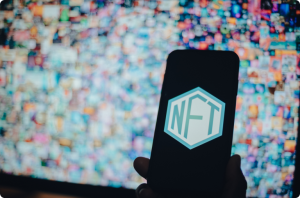In recent years, the digital art world witnessed a revolution with the rise of Non-Fungible Tokens (NFTs). These unique digital assets took the art market by storm, offering a new way to buy, sell, and own digital artwork. However, as the hype around NFTs reached its peak, cracks in the foundation began to appear. Today, we explore the downfall of NFTs and the bursting of the bubble that once seemed invincible. In this piece, we’ll discover how the rise and fall of NFTs highlight the transformative potential and challenges of blockchain technology in the digital art world.
The Initial Hype
Non-Fungible Tokens gained popularity due to their ability to authenticate and verify ownership of digital assets using blockchain technology. They offered a groundbreaking solution to the long-standing problem of digital art’s reproducibility and lack of scarcity. As artists capitalized on the NFT frenzy, commanding staggering prices for their artwork, collectors seized a lucrative opportunity to invest in the ever-evolving landscape of digital assets.
Unsustainable Environmental Impact
One of the major criticisms against NFTs was their massive carbon footprint. The underlying blockchain technology used in most NFT platforms, such as Ethereum, utilized a mechanism known as “proof-of-work,” NFT platforms heavily rely on energy-intensive processes, consuming a significant amount of power comparable to the annual electricity consumption of an entire nation. As awareness surrounding the ecological impact and environmental consequences intensified, the backlash against NFTs gained momentum.
Lack of Intrinsic Value
While the notion of possessing an unique digital asset appeared enticing, the issue of intrinsic value emerged prominently. Unlike physical art, which allows for the admiration of aesthetics, texture, and artistry, NFTs heavily depend on their digital nature. The valuation of NFTs predominantly originated from the speculative market, fueled by hype, endorsements from celebrities, and the potential for NFT future profits. With the influx of numerous new NFTs saturating the market, numerous collectors began to doubt the genuine value of their digital acquisitions.
Copyright Concerns and Originality
Another challenge faced by NFTs was the issue of copyright infringement and originality. NFT platforms often allowed anyone to mint and sell their digital art without verifying the artist’s rights or the authenticity of the work. This lack of oversight led to numerous instances of stolen and plagiarized art being sold as NFTs, damaging the trust and reputation of ecosystem. Artists found it difficult to protect their creations and faced the risk of seeing their own work profited from by others.
Market Saturation and Lack of Demand
As the NFT frenzy reached its peak, the market became saturated with an overwhelming number of digital assets. Every artist, celebrity, and influencer seemed to jump on the NFT bandwagon, flooding the market with new releases. This oversupply, coupled with a limited number of collectors and investors, resulted in a decline in demand. The bubble had burst, and prices began to plummet.
The Aftermath
Following the initial hype, the NFT market experienced a significant downturn. Prices for NFTs that once reached astronomical heights tumbled, leaving many investors with big losses. Artists who had joined the NFT craze as a means to monetize their work were left disillusioned and disheartened.
However, amidst the downfall, some argue that NFTs may find their place in niche markets or evolve into a more sustainable form. Artists and platforms are exploring alternative blockchain solutions with less environmental impact, and industry standards for verifying originality and ownership are being developed.
Conclusion
The rapid rise and subsequent downfall of NFTs serves as a cautionary tale about the dangers of speculative markets and unsustainable hype. While the concept of owning digital assets through NFTs was initially promising, the lack of intrinsic value, environmental concerns, copyright challenges, NFT market saturation, and declining demand led to the bubble bursting. The future of NFTs remains uncertain, but the lessons learned from this experience will undoubtedly shape the path forward for the digital art market and blockchain technology as a whole.






